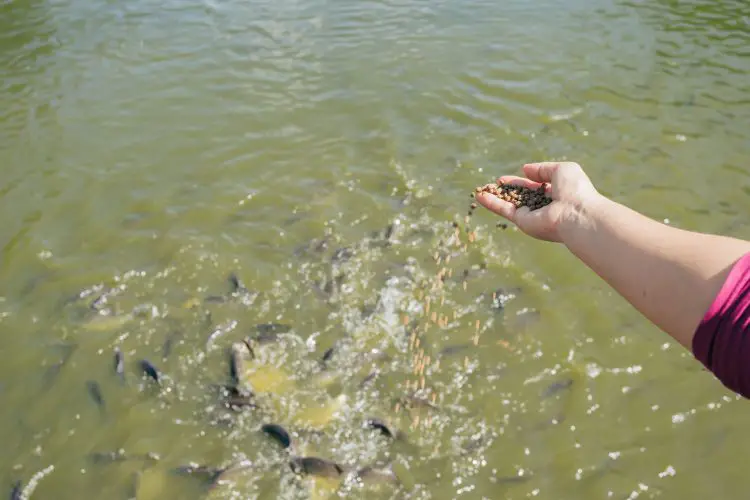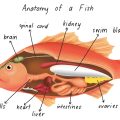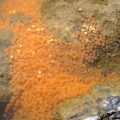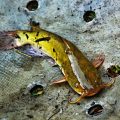Catfish love to not work hard for food. They eat whatever is abundant in the water they occupy. They are mostly bottom feeders and will search for whatever is an easy meal at that location. Given their large olfactory ability all over their bodies and their barbels they can use these to be able to locate a meal in the water. However, there are some species of catfish that like to hunt their prey, considering the large variety of species of catfish found in the wild.
The diet of catfish in the wild
To understand the method by which catfish eat food, you need to first know what they eat in the wild. As you know, there are around 3,000 different catfish in the wild. This means different species of catfish eat different foods and thus have different ways of finding food. Some catfishes are herbivores, carnivores, or parasitic, but most catfishes are omnivorous. The diet of most catfish includes anything that they can fit in their mouths. Some examples of food items they eat are,
- Water insects and other small insects
- Crayfish
- Small fishes
- Phytoplankton
- Algae
- Snails
- Shrimps
- Water beetles
- Plants
- Fish eggs
- Small mammals
These are some of the generic food items that catfish eat. Considering the different food items, they can eat they can survive anywhere. Some huge catfish even eat rodents, birds, and frogs that are around the water. Some catfish also feed on nuts and fruits. As you can tell, their diet is very diverse and depends on where the catfish are present and what is available in the water.
Blue catfish are fish that eat almost everything, and their population is growing dramatically. Similarly, channel catfish, flathead catfish, and North African catfish all have slightly different food items in their diets. Interestingly, most catfish change their diet as they grow older; the younger catfish prefer smaller, easier-to-find food items. Most catfish are cannibalistic as well; they eat their own species, other catfish, and even their own eggs sometimes.
Dead fish as prey
You already know that many fish eat other small fish that fit in their mouths. However, do they also eat fish and other prey that are already dead? Many fishes might not prefer to eat dead fishes, but catfish don’t mind. In fact, dead fish make great bait since they smell so strongly and can attract catfish. Despite that, catfish still prefer live fish over dead ones, as the fresher fish, the less chance of disease it will have.
Different ways fish get food
Here are some different ways that fish, like catfish, obtain food in the wild. The most effective way of collecting food varies from fish to fish. The juvenile fishes usually start off as herbivores as they are not old enough to attack another fish and it makes it easier for them to digest. Slowly, as they grow, some catfish become aggressive and develop predatory behavior, after which they attack other small fishes and live organisms.
Filter feeders
This is a way of eating food in which a fish strains suspended food matter and particles from the water. They have a special strainer in their mouth that allows them to strain the food that they eat from a large quantity of water. It is a useful way of eating food when the food item is small and hard to look for. This unique way of eating is usually used by sharks and whales. Catfish can sometimes act as filter feeders as well, usually at the bottom of the water when looking for food.
Herbivores
These fishes don’t have to look that hard to look for food since they survive on non-living materials. Herbivores look for places with a lot of sunshine, as it promotes algae growth, which is their main food source, and plants that grow underwater. Herbivores are a very important part of the ecosystem, especially for the health of coral reefs. They clean them by eliminating excess algae that grow around them and can compete for food. These fish love to keep the tank clean by grazing on any extra algae in captivity. Moreover, they also love fruits and other such food items in captivity.
Carnivores
Now, carnivores are the meat-eating fishes that have to either hunt their prey or capture it through other means. Fishes that are carnivores are the ones that have to work a little hard to capture the prey and use special techniques. Usually, these fishes can swim pretty fast to surprise the prey and catch them or hide and attack the fish when it is least expecting it. They depend on their smelling ability as well, which is better than other types of fish.
Some carnivores in shallow water flourish because the weed beds have lots of hidden small fishes. Moreover, some fish that are in rivers depend on the current of water flow to bring them food, and the current of the river usually brings fry and other fish eggs that cannot yet navigate the river. As you can see, carnivorous fishes are very well adapted to hunting for prey in any water environment.
Omnivorous
These are the best-suited fishes to any environment because they can eat both plants and algae, along with small fishes and other small creatures. These fish are opportunistic, which means that they eat whatever they find and do not have a food preference like other fish do. Most of the catfishes are omnivorous as they have adapted to live for a long time. These fishes can deal with lack of food the best as they can eat whatever they find. Moreover, omnivorous fishes are very to take care of in any home tank as well due to the variety of food you can feed them. Omnivorous fishes are more likely to survive everywhere. In conclusion, catfishes and all other fishes are adapted very well to how they get their food, especially carnivores and omnivores. They have barbels that aid in searching for prey and other features as well. So, in short, they have had millions of years to adapt to their surroundings.













Pingback: What is the Difference Between Catfish and Eel? | Reel Fishing Guru
Pingback: What is the Difference Between Catfish and Hardhead? Identifying Key Variations | Reel Fishing Guru
Pingback: Will Catfish Eat Cheese as Bait? Unveiling Effective Angling Secrets | Reel Fishing Guru